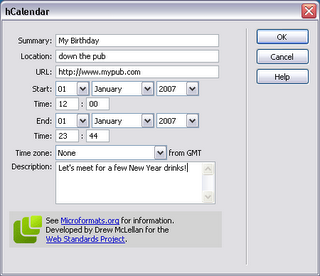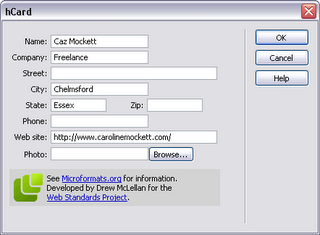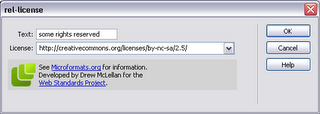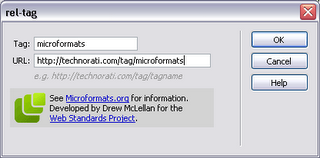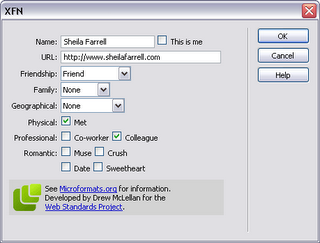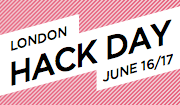WebCards Extension For FireFox
Discovering Microformats
For viewing Microformats, and discovering them in a web page, I've blogged about Tails for Firefox in the past. But recently, I've been beta testing Andy Mitchell's excellent Webcards 0.3 extension for Firefox. So what does it do?
The first time you load a page containing Microformatted information, the green WebCards ribbon pops up at the bottom of the browser viewport to alert you. This also appears when you mouse over the bottom of the browser: [WebCards ribbon tells you what sort of Microformats are in the page]
[WebCards ribbon tells you what sort of Microformats are in the page]
Playing Tag
Clicking the "Tags" link in the ribbon brings up the Tags panel: [Default view of the "tags" panel is the Related option, allowing easy search of del.icio.us or Upcoming for the tags in question; "brian suda" in this example.]
[Default view of the "tags" panel is the Related option, allowing easy search of del.icio.us or Upcoming for the tags in question; "brian suda" in this example.]
Similarly, clicking the Feedback or Media icons gives alternative search options for that tag:

[Feedback offers to search Technorati, Media offers to search Flickr for the tag in question]
An alternate way to access the tags panel is to right click any tag on the page (which will be highlighted by the green ![]() icon):
icon): [Right-click (configurable) the TAG icon to get a floating version of the Tags panel]
[Right-click (configurable) the TAG icon to get a floating version of the Tags panel]
Making Contact
When displaying contact information, the extension will display the blue ![]() icon whenever it encounters any hCard info. Right click to get the floating panel for the hCard information:
icon whenever it encounters any hCard info. Right click to get the floating panel for the hCard information: [Default view for hCard is the Information icon. Shows multiple links if they are in the hCard]
[Default view for hCard is the Information icon. Shows multiple links if they are in the hCard]
The Application icon will allow export of the hCard info to Outlook or other address book application. The Related icon shows other search options for that person: [Related search options are LinkedIn, Google or Wikipedia]
[Related search options are LinkedIn, Google or Wikipedia]
Getting Friendly
My blogroll is marked up with XFN and when you mouse over the relevant link, WebCards will let you see the orange ![]() icon. Right click and it shows relationship in the XFN panel:
icon. Right click and it shows relationship in the XFN panel: [The XFN panel shows the page owner's relationship to the linked person]
[The XFN panel shows the page owner's relationship to the linked person]
Make A Date
The last major category of Microformat that I've been exploring with WebCards is of course, hCalendar. These are indicated by the little red ![]() icon:
icon: [Upcoming occasions displayed in the Calendar panel]
[Upcoming occasions displayed in the Calendar panel]
As with the other format panels, the Application icon lets you export the event to Outlook or Google Calendar applications; Related will search Upcoming or Google for the event: [Add an event to my GoogleCalendar with the Applications icon]
[Add an event to my GoogleCalendar with the Applications icon]
Summing Up
So far, I've seen several iterations of this extension, and Andy has always welcomed feedback on the app. I like it a lot better than Tails for Firefox, it just seems to do more and looks much nicer - don't accuse me of being shallow, it just adds up to a nicer user experience! Anyway, I'd recommend it to anyone who is looking to get the most out of Microformats in the wild.


